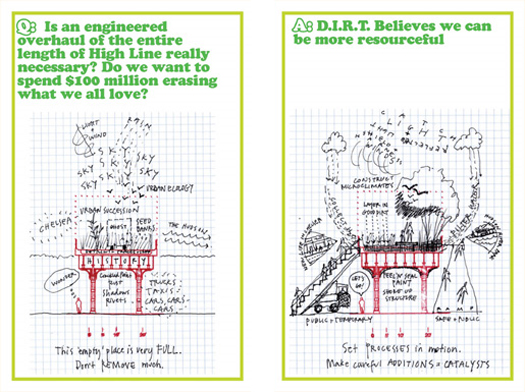The High Line receives a glowing review from the New York Review of Books (which, due their odd desire to maintain the pretense that they publish book reviews and not journalism, pretends that the article is a review of the pamphlet-sized Designing the High Line, though it merits only a single paragraph in the article).

I’ve always thought it unfortunate that the TerraGRAM team didn’t have the chance to realize their vision, which, as an article in Metropolis pointed out several years ago, was the one entry to the original competition that “had the confidence and the humility to let the High Line be the High Line”. Its hard not to feel that the eventual approach adopted by Field Operations and DSR — disassembling the structure and then reassembling it as a simulacrum of its prior self, a planting plan that mimics the appearance but not the process of the wilderness it replaces — is somewhat disingenious and disappointingly second-best (even if their hand was forced in that direction), particularly in comparison to the TerraGRAM approach, which was so focused on enabling processes and communities of curation (though, obviously, not everyone agrees, and perhaps I’ll have a different opinion once I’m able to visit).


Rob, Glad I came across this post. I’m one of those contrarians when it comes to the high line, but wasn’t aware of TerraGRAM’s proposal until now. The idea of a wilderness amidst the urban is a polarizing concept, but surely didn’t gets its due consideration. Arguably, the high line park would never have been designed as it is without its former life, so in that respect it’s unique. Still, my opinion is it falls drastically short of being something it was already on the way to becoming.
Definitely agree, Tommy — I read your post on the High Line a while back, and agreed with a lot of what you had to say. (There’s actually been a draft of a longer post about the High Line sitting around on my computer for a few weeks now that tied together some of my thoughts with what you said and John’s comments over at Archidose, but I don’t know that I’m going to bother pulling it together now.)
[…] Line, which approaches the High Line from a rather different perspective than the one I’ve tended to bring to it (bemoaning the loss of the landscape that had developed over time, etc.). A couple of nice […]
[…] by Van Valkenburgh’s office, including the TerraGRAM High Line scheme that I’ve previously mentioned my fondness for), and UrbanLab’s eco-boulevard proposal for Chicago, “Growing […]
[…] urban space which draws its appeal specifically from that mess and dis-use, but where the High Line parodies and imitates that appeal, the incremental additions Milligan describes amplify its appeal. The […]